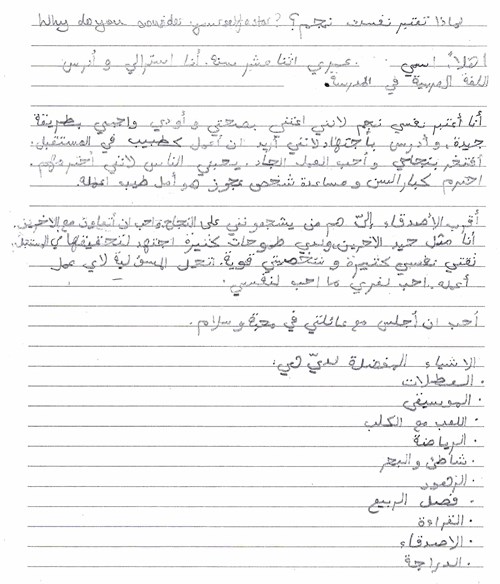Languages: Arabic - Satisfactory - Years 9 and 10 (Year 7 entry)
Portfolio summary
This portfolio of student work shows that the student can use written and spoken Arabic to initiate and sustain interactions with peers and adults (WS2, WS3, WS5). The student uses language spontaneously to exchange ideas (WS1, WS5), opinions and feelings, compare experiences and discuss future plans (WS2, WS3). The student sustains interactions by asking and responding to questions, requesting clarification, elaborating on opinions, and expressing agreement or disagreement (WS2). In classroom interactions, the student shares ideas and suggestions, negotiates options, solves problems and completes transactions (WS2, WS3). The student applies pronunciation and intonation rules to convey emotions and enhance expression (WS2, WS3, WS5). The student obtains information from multiple sources on a range of issues and analyses and evaluates meaning, gist and purpose. The student conveys ideas and viewpoints from a range of perspectives using different text types and modes of presentation selected to suit different audiences and to achieve different purposes (WS4, WS5). The student shares their responses to different imaginative texts by expressing opinions on themes, events and values and explaining key ideas and messages. The student manipulates language and uses different techniques to produce imaginative texts in a range of forms that draw on past experiences or future possibilities (WS1, WS2, WS3, WS6). When creating texts, the student uses a variety of grammatical elements (WS3, WS6), such as conditional and subjunctive moods, embedded clauses and imperative forms, future tense and vocative case to convey meaning (WS1, WS2, WS4, WS5). The student uses vocabulary and expressions that are culturally embedded (WS2, WS3, WS5, WS6) and applies appropriate writing conventions to increase text cohesion and enhance expression (WS4, WS5). The student translates and interprets texts from Arabic into English and vice versa (WS2), comparing own interpretations with others’ and explaining reasons for differences in translations. The student creates bilingual texts for the wider community, interpreting cultural and linguistic aspects of texts (WS1, WS2, WS6). The student explains how cultural concepts, practices and values influence ways in which they communicate from a bilingual perspective (WS3, WS5, WS6), and questions assumptions and describes adjustments they make when moving from Arabic to English and vice versa (WS1, WS6).
The student identifies the meaning and emotions conveyed in spoken texts and applies their understanding of the Arabic writing system to enhance meaning and aesthetic effect in written texts. The student analyses the relationship between language choices and textual features, and the audience, purpose and context of different spoken, written and multimodal texts (WS3). The student explains how spoken and written forms of Arabic vary according to context, purpose and audience, and identifies ways in which the Arabic language influences and is influenced by cultural, political and social change (WS1, WS2, WS3, WS6). The student explains the power of language in determining the nature of intercultural communication in local and global contexts (WS1, WS3, WS6).





